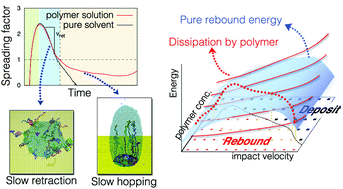Suppressing the rebound of impacting droplets from solvophobic surfaces by polymer additives: polymer adsorption and molecular mechanisms†
Abstract
A liquid droplet impacting on a solvophobic surface normally rebounds. The rebound is suppressed by a small amount of dissolved polymer. In this work, using multi-body dissipative particle dynamics simulations, two anti-rebound mechanisms, the slow-retraction and the slow-hopping mechanisms, are identified. Which of them dominates depends on the polymer–surface attraction strength. However, these two mechanisms do not exclude each other but may coexist. During the droplet rebound, the surface-adsorbed polymer acts in two ways: the adsorbed beads mediate the solvent–surface interactions, and the highly stretching unadsorbed polymer segment exerts a retraction force on the liquid. Both actions increase the friction against retraction and the resistance against hopping. We also investigate the effects of the molecular weight and the concentration of the polymer additive, the droplet size, and the impact velocity on the rebound tendency. As the first work to provide a microscopic explanation of the anti-rebound mechanism by polymer additives, this study allows better understanding of wetting behavior by polymer–solution droplets.



 Please wait while we load your content...
Please wait while we load your content...